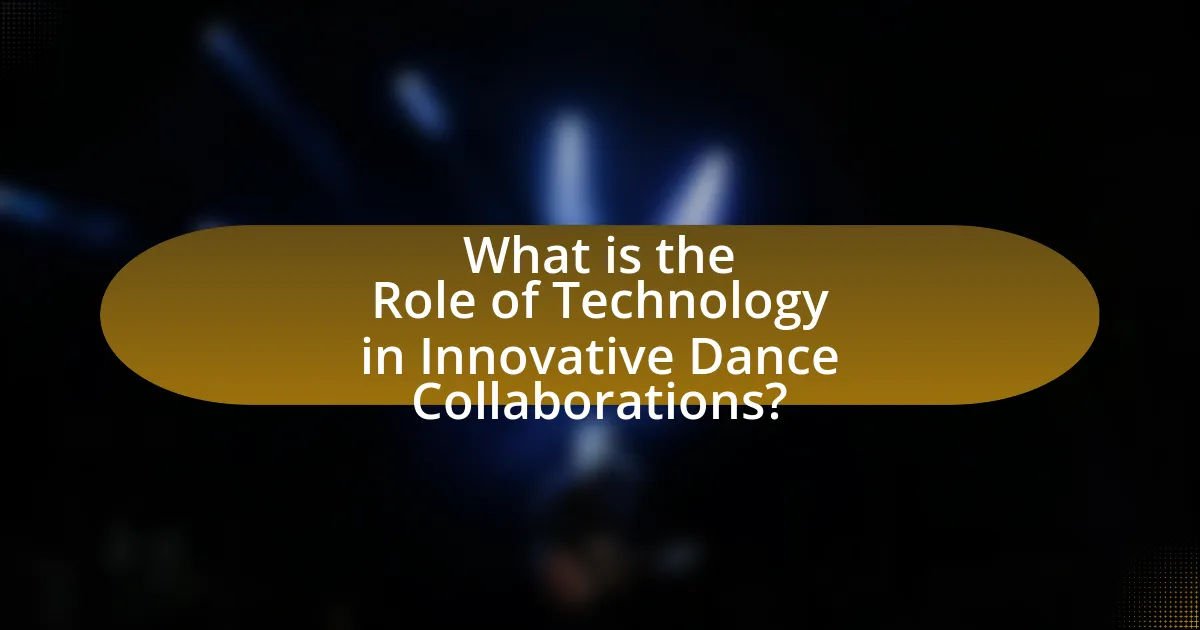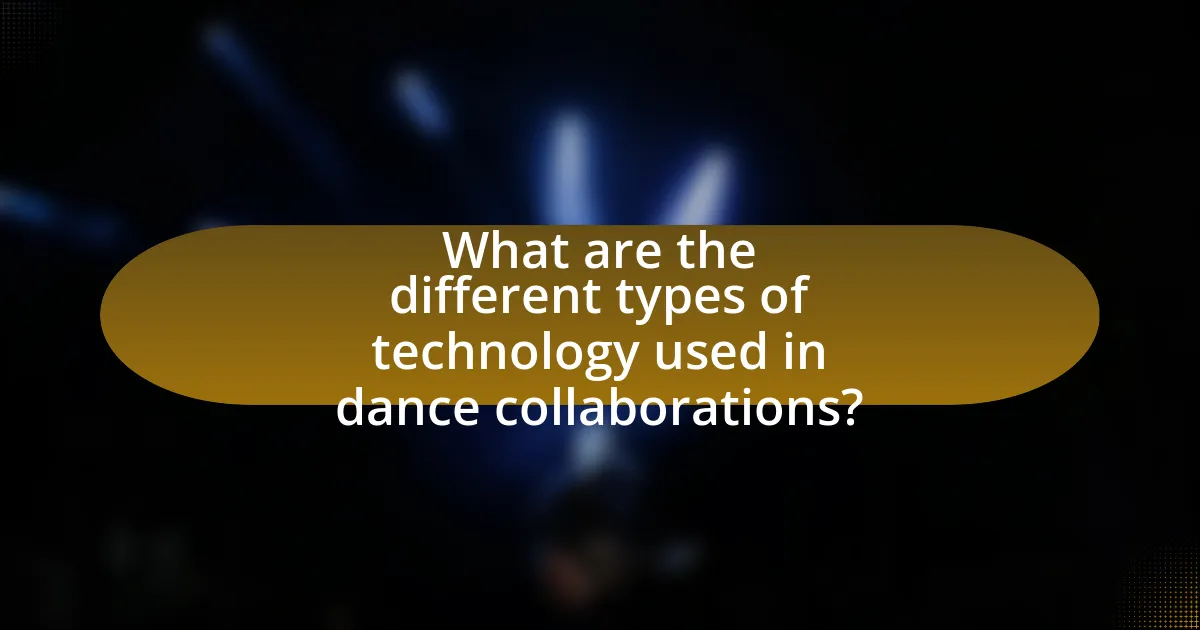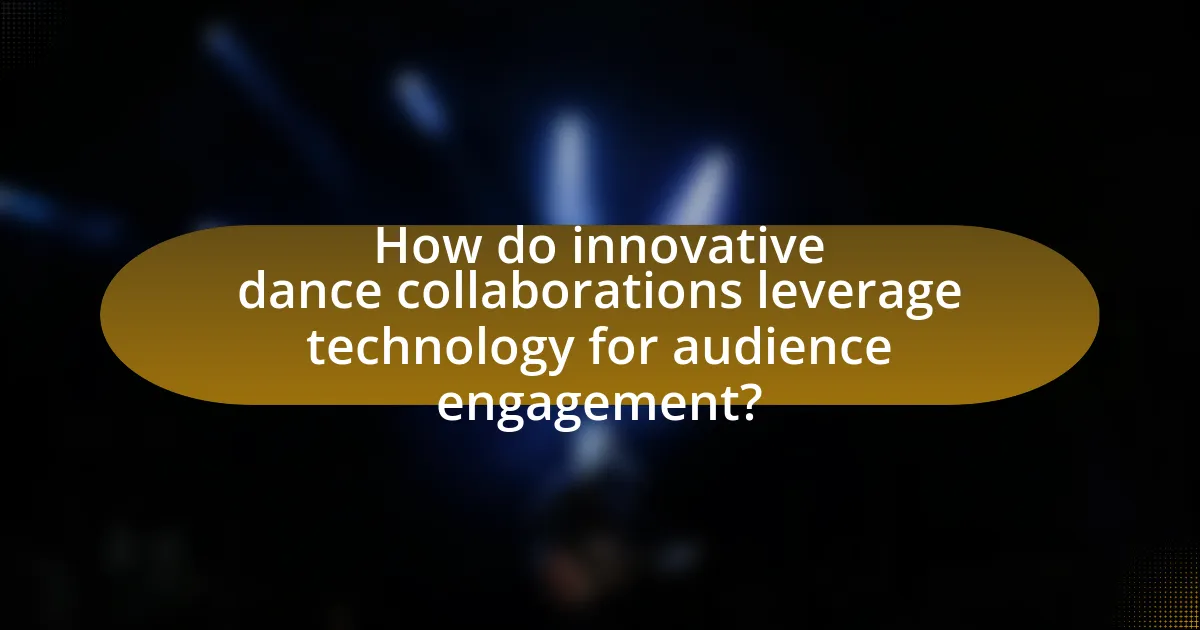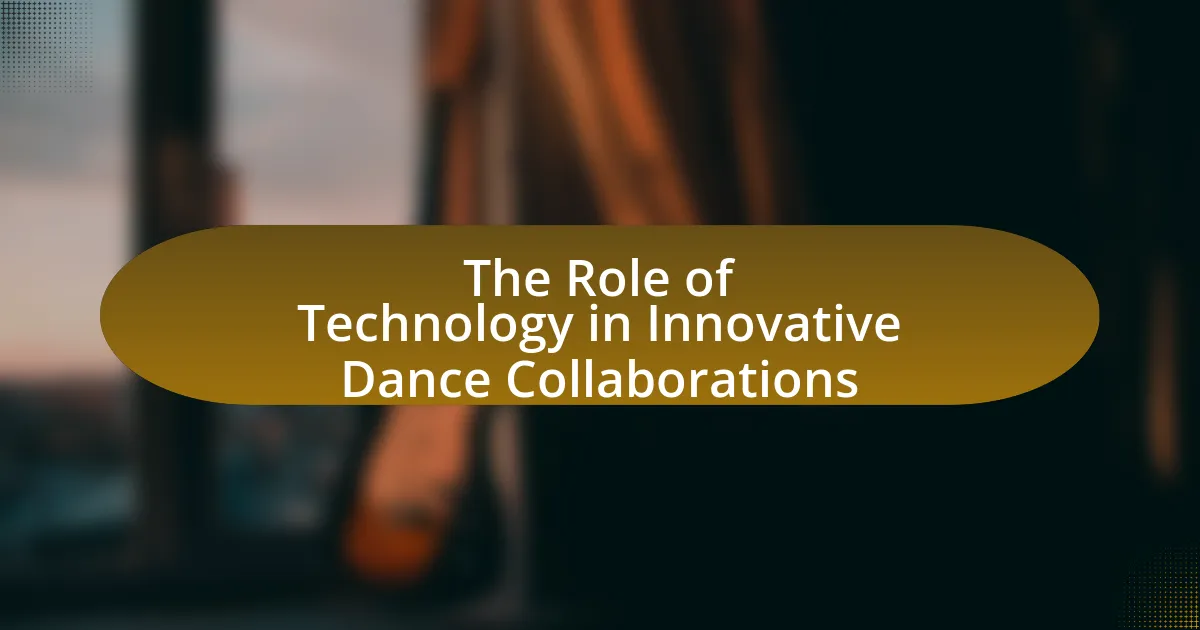The article examines the significant role of technology in innovative dance collaborations, highlighting how it enhances creativity, facilitates communication, and expands audience engagement. It discusses various technological tools such as motion capture, video conferencing, and digital media that enable real-time collaboration among dancers and choreographers across geographical boundaries. The article also addresses the transformative impact of technology on choreography development, audience interaction, and the overall artistic process, while identifying common challenges faced without technological integration. Additionally, it outlines best practices for effectively incorporating technology into dance collaborations to maximize artistic expression and collaboration efficiency.

What is the Role of Technology in Innovative Dance Collaborations?
Technology plays a crucial role in innovative dance collaborations by enhancing creativity, facilitating communication, and expanding the reach of performances. Through tools such as motion capture, digital media, and virtual reality, choreographers and dancers can experiment with new forms of expression and create immersive experiences. For instance, the use of motion capture technology allows for the analysis and integration of complex movements, enabling dancers to collaborate across distances in real-time. Additionally, platforms like social media and streaming services provide opportunities for wider audience engagement and collaboration among artists from diverse backgrounds. These technological advancements not only enrich the artistic process but also democratize access to dance, allowing for a broader exchange of ideas and styles.
How has technology transformed the landscape of dance collaborations?
Technology has significantly transformed the landscape of dance collaborations by enabling remote participation and enhancing creative possibilities. Digital platforms allow dancers and choreographers from different geographical locations to collaborate in real-time, utilizing tools like video conferencing and cloud-based software for sharing choreography and feedback. For instance, during the COVID-19 pandemic, many dance companies adopted virtual rehearsals, demonstrating that technology can maintain artistic collaboration despite physical distance. Additionally, advancements in motion capture and augmented reality have expanded the ways in which dance can be created and experienced, allowing for innovative performances that blend physical movement with digital elements. This integration of technology not only fosters inclusivity but also encourages experimentation, leading to new forms of artistic expression in dance.
What technological tools are most commonly used in dance collaborations?
The most commonly used technological tools in dance collaborations include video conferencing software, motion capture technology, and digital collaboration platforms. Video conferencing tools like Zoom and Skype facilitate real-time communication and rehearsal among dancers in different locations. Motion capture technology, such as Vicon or Kinect, allows for the analysis and recording of movement, enabling choreographers to create and refine dance sequences digitally. Digital collaboration platforms, including Google Drive and Dropbox, provide shared spaces for dancers and choreographers to exchange materials, such as videos and scores, enhancing the collaborative process. These tools have been increasingly adopted in the dance community, particularly during the COVID-19 pandemic, which necessitated remote collaboration.
How do these tools enhance creativity and expression in dance?
Technology enhances creativity and expression in dance by providing innovative tools that facilitate new forms of movement and choreography. For instance, software applications allow dancers to visualize and manipulate their movements in real-time, enabling them to experiment with different styles and techniques. Additionally, wearable technology can track physical movements and provide feedback, which helps dancers refine their skills and explore new creative avenues. Research has shown that integrating technology in dance not only broadens artistic possibilities but also fosters collaboration among artists, as seen in projects that combine dance with digital media, enhancing the overall expressive potential of performances.
Why is technology essential for modern dance collaborations?
Technology is essential for modern dance collaborations because it enhances creativity, facilitates communication, and expands the reach of performances. The integration of digital tools allows choreographers and dancers to experiment with new forms, such as virtual reality and motion capture, which can lead to innovative artistic expressions. Additionally, technology enables real-time collaboration across geographical boundaries, allowing artists to work together regardless of location. For instance, platforms like Zoom and collaborative software have become vital for rehearsals and discussions, especially during the COVID-19 pandemic, which highlighted the need for remote collaboration. Furthermore, technology aids in the distribution of dance performances through streaming services, increasing accessibility and audience engagement.
What challenges do dancers face without technology in collaborations?
Dancers face significant challenges in collaborations without technology, primarily due to limitations in communication and coordination. Without digital tools, dancers struggle to share choreography, music, and visual references efficiently, leading to misunderstandings and inconsistencies in performance. For instance, the absence of video conferencing restricts real-time feedback and collaboration, which can hinder the creative process. Additionally, the lack of technology limits access to resources such as online tutorials and digital platforms for sharing work, making it difficult for dancers to develop their skills and connect with a broader audience. These challenges highlight the critical role technology plays in enhancing collaboration and creativity in dance.
How does technology facilitate communication among collaborators?
Technology facilitates communication among collaborators by providing various platforms and tools that enable real-time interaction and information sharing. For instance, video conferencing applications like Zoom and collaboration tools such as Slack allow dancers and choreographers to connect regardless of geographical barriers, enhancing teamwork and creative exchange. Research indicates that 70% of remote teams report improved communication through the use of digital collaboration tools, demonstrating their effectiveness in fostering collaboration.

What are the different types of technology used in dance collaborations?
The different types of technology used in dance collaborations include digital media, motion capture, augmented reality, virtual reality, and interactive software. Digital media allows for the integration of video and audio elements into performances, enhancing the visual experience. Motion capture technology enables the recording of dancers’ movements, which can be analyzed and used to create digital avatars or choreographic tools. Augmented reality overlays digital information onto the physical world, allowing for immersive experiences that blend live performance with digital enhancements. Virtual reality creates entirely immersive environments where dancers can interact with virtual elements. Interactive software facilitates real-time collaboration among dancers and choreographers, enabling them to create and modify choreography dynamically. These technologies have transformed the landscape of dance, allowing for innovative expressions and collaborations that were previously unattainable.
How do digital platforms influence dance collaboration?
Digital platforms significantly enhance dance collaboration by facilitating real-time communication and providing access to a global network of artists. These platforms enable dancers, choreographers, and producers to connect regardless of geographical barriers, allowing for diverse creative input and collaboration on projects. For instance, tools like Zoom and social media platforms have been utilized for virtual rehearsals and workshops, which became particularly prominent during the COVID-19 pandemic, demonstrating their effectiveness in maintaining artistic collaboration under challenging circumstances. Additionally, platforms like YouTube and Instagram allow for the sharing of choreography and dance styles, fostering inspiration and innovation within the dance community.
What are the benefits of using social media for dance collaborations?
Using social media for dance collaborations enhances visibility, connectivity, and creativity among dancers. Social media platforms allow dancers to showcase their work to a global audience, facilitating networking opportunities and collaborations that may not have been possible otherwise. For instance, a study by the Pew Research Center indicates that 69% of adults in the U.S. use social media, providing a vast pool of potential collaborators and audiences. Additionally, social media enables real-time feedback and interaction, fostering a dynamic creative process where dancers can share ideas and receive instant responses, thus enriching the collaborative experience.
How do video conferencing tools enhance remote collaborations?
Video conferencing tools enhance remote collaborations by facilitating real-time communication and interaction among team members regardless of their geographical locations. These tools enable participants to share visual and auditory information instantly, which is crucial for collaborative tasks such as brainstorming, feedback sessions, and project updates. According to a study by the International Journal of Information Management, 70% of remote teams reported improved communication and collaboration efficiency when using video conferencing platforms. This improvement is attributed to features like screen sharing, virtual whiteboards, and breakout rooms, which allow for a more engaging and interactive experience, ultimately leading to better teamwork and productivity in remote settings.
What role does motion capture technology play in dance?
Motion capture technology plays a crucial role in dance by enabling the precise recording and analysis of dancers’ movements. This technology captures the intricate details of choreography, allowing for the creation of digital representations that can be used for various purposes, including performance enhancement, choreography development, and educational tools. For instance, studies have shown that motion capture can improve the accuracy of dance instruction by providing visual feedback to dancers, thereby enhancing their learning experience. Additionally, it facilitates the integration of dance with other art forms, such as film and video games, by allowing choreographers to visualize and manipulate movements in a digital space.
How does motion capture contribute to choreography development?
Motion capture significantly enhances choreography development by providing precise data on movement, allowing choreographers to analyze and refine dance sequences. This technology captures the nuances of human motion, translating them into digital formats that can be manipulated and studied. For instance, a study by the University of Southern California demonstrated that motion capture can improve the accuracy of movement replication in dance, leading to more innovative and complex choreography. By utilizing this data, choreographers can experiment with new styles and techniques, ultimately pushing the boundaries of traditional dance forms.
What are the implications of using motion capture for performance?
The implications of using motion capture for performance include enhanced precision in movement analysis and the ability to create immersive experiences. Motion capture technology allows performers to translate their physical movements into digital data, which can be manipulated for various artistic expressions. This technology has been utilized in productions such as “Avatar” and “The Lion King,” where it enabled the creation of lifelike animations and interactions between characters. Furthermore, studies have shown that motion capture can improve choreography by providing detailed feedback on movement quality and timing, thus fostering innovation in dance collaborations.

How do innovative dance collaborations leverage technology for audience engagement?
Innovative dance collaborations leverage technology for audience engagement by utilizing interactive platforms, augmented reality, and live streaming to create immersive experiences. These technologies allow audiences to participate in performances in real-time, enhancing their connection to the art form. For instance, companies like 605 Collective have integrated mobile apps that enable viewers to influence choreography through their choices, demonstrating how technology can transform passive spectators into active participants. Additionally, the use of social media and virtual reality has expanded the reach of performances, allowing global audiences to engage with dance in ways that were previously impossible, thus increasing accessibility and fostering community interaction.
What are the ways technology enhances audience interaction in dance performances?
Technology enhances audience interaction in dance performances through immersive experiences, real-time feedback, and interactive elements. Immersive experiences are created using augmented reality (AR) and virtual reality (VR), allowing audiences to engage with the performance environment, as seen in productions like “The Night Cafe,” where viewers can explore a 3D space inspired by Van Gogh’s art. Real-time feedback mechanisms, such as mobile apps, enable audiences to influence choreography or music, exemplified by the app used in “Dance Your PhD,” where viewers’ votes shaped the performance. Interactive elements, including motion sensors and audience participation tools, invite spectators to become part of the performance, as demonstrated in “The Dancer’s Voice,” where audience movements directly affected the dancers’ actions on stage. These technological advancements create a dynamic relationship between performers and audiences, enhancing engagement and participation.
How do augmented reality and virtual reality create immersive experiences?
Augmented reality (AR) and virtual reality (VR) create immersive experiences by fully engaging users in interactive environments that blend digital content with the real world or create entirely virtual spaces. AR enhances the real-world environment by overlaying digital information, allowing users to interact with both physical and virtual elements simultaneously, which can be particularly effective in dance collaborations by providing visual cues and enhancing choreography. VR, on the other hand, transports users into a completely virtual environment, enabling them to experience and participate in dance performances as if they were physically present, thus fostering a deeper emotional connection to the art form. Research indicates that immersive technologies can increase user engagement and emotional responses, as evidenced by studies showing that participants in VR environments report higher levels of presence and enjoyment compared to traditional media formats.
What impact does live streaming have on audience reach and participation?
Live streaming significantly enhances audience reach and participation by allowing real-time interaction and access to events from anywhere in the world. This technology eliminates geographical barriers, enabling a broader audience to engage with performances, as evidenced by a report from Statista indicating that live streaming events can attract up to 10 times more viewers than traditional formats. Additionally, platforms like Twitch and YouTube Live facilitate audience interaction through chat features, fostering a sense of community and increasing viewer engagement during performances.
What best practices should be followed for successful technology integration in dance collaborations?
Successful technology integration in dance collaborations requires clear communication, collaborative planning, and ongoing evaluation. Clear communication among all participants ensures that everyone understands the technological tools being used and their roles in the collaboration. Collaborative planning involves selecting appropriate technologies that enhance the artistic vision and facilitate creative processes, such as video conferencing tools for remote rehearsals or software for choreography documentation. Ongoing evaluation allows teams to assess the effectiveness of the technology in achieving their goals, making adjustments as necessary to improve the integration process. These practices are supported by research indicating that effective communication and planning significantly enhance collaborative outcomes in artistic projects.
How can dancers effectively choose the right technology for their needs?
Dancers can effectively choose the right technology for their needs by assessing their specific requirements, such as the type of dance, performance goals, and the desired audience engagement. For instance, if a dancer aims to enhance choreography through video analysis, they should consider software that offers motion capture and playback features. Additionally, researching user reviews and case studies can provide insights into how other dancers have successfully integrated technology into their practice. According to a study published in the Journal of Dance Education, 78% of dancers reported improved performance outcomes when utilizing technology tailored to their specific artistic goals. This evidence underscores the importance of aligning technology choices with individual needs and objectives.
What common pitfalls should be avoided when using technology in dance collaborations?
Common pitfalls to avoid when using technology in dance collaborations include over-reliance on technology, lack of clear communication, and insufficient technical training. Over-reliance on technology can lead to diminished creativity and spontaneity, as dancers may become too focused on the technical aspects rather than the artistic expression. Lack of clear communication among collaborators can result in misunderstandings and misalignment of artistic vision, which is crucial for cohesive performances. Insufficient technical training can hinder the effective use of technology, causing frustration and limiting the potential of the collaboration. These pitfalls are supported by studies indicating that successful collaborations require a balance between technology and human interaction, emphasizing the importance of communication and skill development in creative processes.
